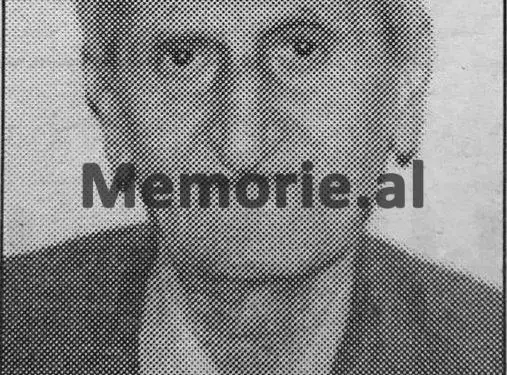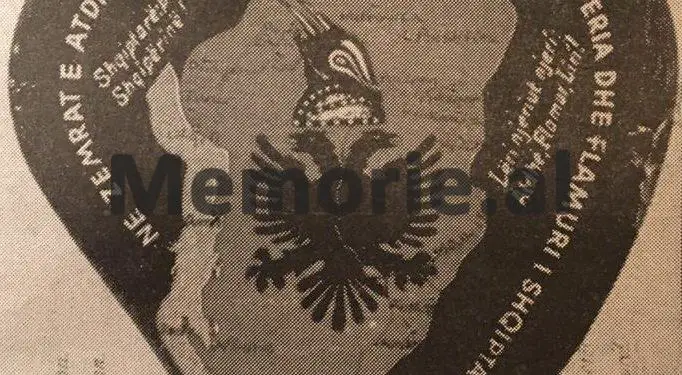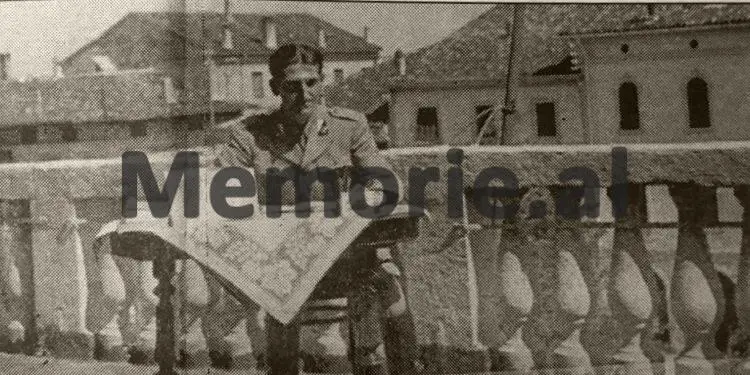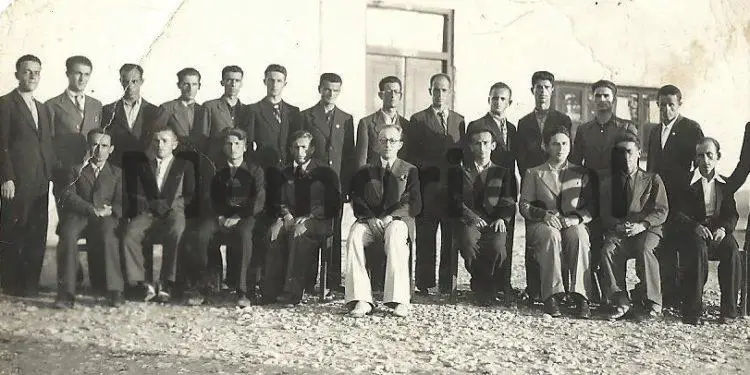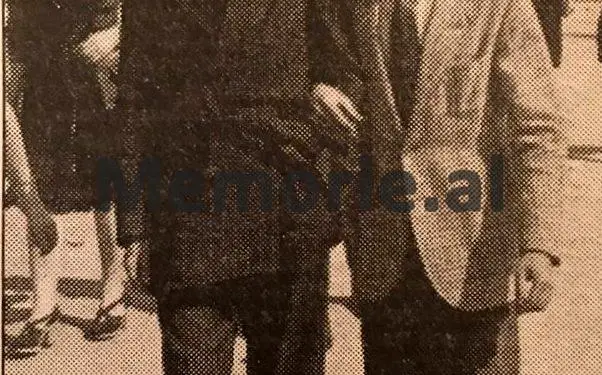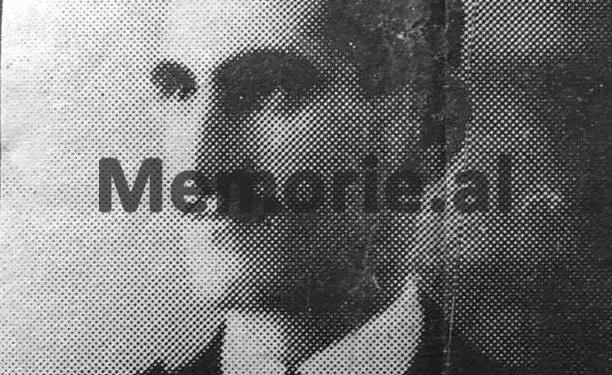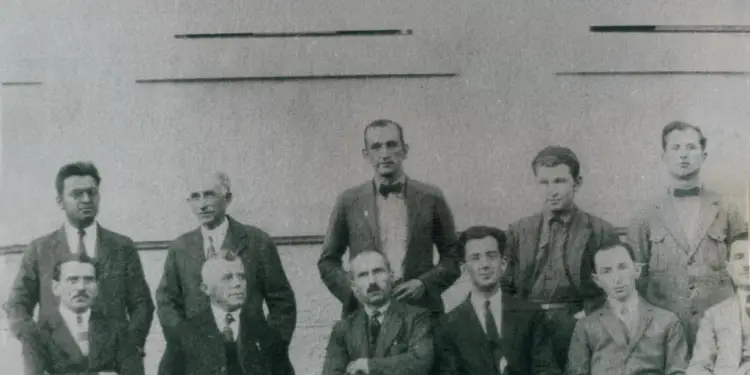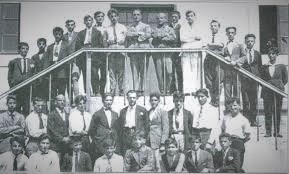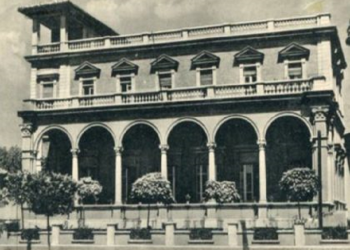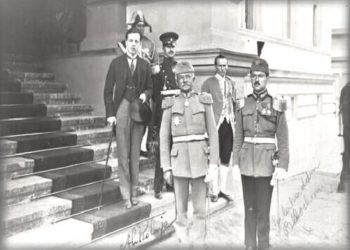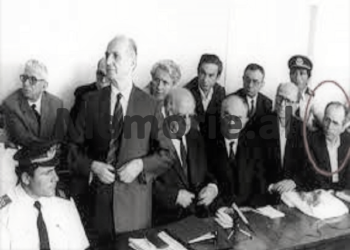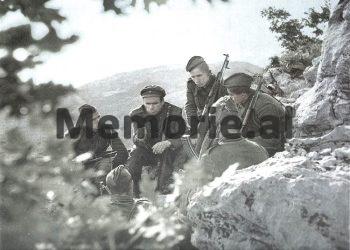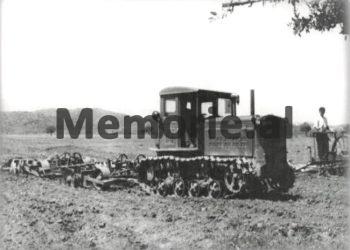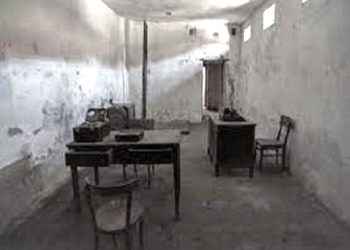Dashnor Kaloçi
Memorie.al publishes the unknown story of Veledin Musaraj, originally from the village of Buzmadh in Mallakastra, in one of the richest and most famous families in the whole province, where his father, Riza Musaraj, is known for his patriotic activity. , in 1919 he moved with his family to the city of Fier and in 1920 he financially helped the volunteers from Fier who went to the Vlora War and in the same year, he accompanied the delegates from Fier who participated in the Congress of Lushnja.
In 1933, Veledini began his studies at the American Technical School of Fultz in Tirana and after graduating with honors in 1938, the government of the Zog Monarchy awarded him a state scholarship to study at the Military Academy in Modena, Italy, where he was accompanied by Asim Zeneli, Elez Braha, Fadil Dashi, Hysen Zotaj, Ilia Naska, Adem Ballhysa, Kristo Xheka, Ihsan Boriçi and Shahin Toçi from Mati.
Veledin’s anti-fascist activity while studying at the Modena Academy, where he drafted and published a map of Ethnic Albania, which he secretly distributed in Kosovo through the Shala family. The appointment of Veledin as a career soldier in the ranks of the Albanian National Army at the Border Guard based in Pristina, where in June ’44, for health reasons he returned to Mallkastra, where thanks to the authority he enjoyed and his family intervened to reach an agreement between the nationalist forces and the communist partisans. How was he persecuted by the communist regime of Enver Hoxha, leaving him to work as a night watchman, for the sole reason that once during the war, he had compiled and distributed the map of Ethnic Albania?!
“Veledin Musaraj, during the enemy operation of June 1943, which took place in Mallakastër, was an officer and asked to create a commission, to make an agreement with the command of the operation, with these conditions, so that the forces would not be hit with weapons Italians and Italians not to burn the village of Buzëmadh…! During the war, he showed hostile activity, in the form of agitation and propaganda, and wrote articles that were completely in line with the fascist propaganda on Greater Albania, for its ethnic borders, demanding Kosovo and Chameria, that with such a slogan, Italy declared war on Greece and Yugoslavia. At this time, our Party was seeking friendship with neighboring peoples. The article is symbolized by ethnic boundaries and hearts hit with arrows. Mondi’s uncle, Fazlli Musaraj, participated in the organization of Balli Kombëtar, was one of its exponents, created the village gang and became its commander “.
This was written, among other things, in a letter received from the city of Fier in the early 1970s to the address of the organization of the Democratic Front of the neighborhood in Tirana where the volleyball player of the “Dinamo” team, Edmon Musaraj, lived, which was caused him to be expelled from the team, on the eve of a very important meeting that would take place in Czechoslovakia. For more about this and the whole story of the Mallakastriote family Musaraj and Veledin, we will be known in this article that Memorie.al has prepared based on the testimonies of Edmon Musaraj and some other sources, from former friends and colleagues of his father, who had graduated from the Military Academy of Modena in Italy.
Who was Veledin Musaraj?
Veledin Musarai, was born in April 1914, in the village of Buzmadh of Mallakastra, in one of the richest and largest families in the whole province, which enjoyed great respect in the surrounding areas. Riza Ali Musaraj (father of Veledin) who was also the first of this family, moved with all his people in 1919 from his hometown and settled in the city of Fier, where he had the help of his close friend, Xhevdet Dishnica. As a sign of respect and gratitude for the help and support he gave, Riza Musaraj became one of the most ardent defenders of Xhevdet Dishnica, especially in one of the largest demonstrations of 1920, which took place in the sub-prefecture of Fier, where Dishinca spoke to the people gathered from the balcony of the sub-prefecture, about the intentions of the Italians who wanted to keep Vlora. Likewise, Rizai joined the 500 Fier fighters who took part in the Vlora War against the Italians, fighting in Babica and in the Koshovica Pass. In January 1920, Rizai was one of the escorts of the Fier delegates to the Lushnja Congress and he became one of their main defenders, a supporter of the Durrës government. Given the good economic situation of the Musaraj family, she helped financially to buy books, many of the poor families in the city, who had children in schools. In this environment of the Musaraj family, one of her sons, Veledini, grew up.
At Fultz’s American Technical School
In the late 1920s, one of the top leaders of the American Red Cross, who had come to Albania to help the war-torn population (General Crowly), proposed to engineer Hivzi Korça, who had been assigned to work for him., for the distribution of aid and for the opening of a vocational school in Tirana. The director, Crowly, referred that proposal to the director general of the American Red Cross, who immediately gave his approval and with the approval of the Ministry of Education and the government of that time, the opening of that school, now known as ‘Fultz technician, in honor of one of the longest-serving directors who served there, Harry Fultz. In 1933, Veledin Musaraj, was one of the eight students (of the sub-prefecture of Fier), who by an order of the General Directorate of Education, was assigned to attend that school, from the eight Prefectures of the country. Regarding this, in his memoirs, among others, Veledini writes: “Students appointed by the prefectures, started coming to school on August 21 and on September 1, classes began. The American Red Cross nurses taught us how to eat and stay clean and dressed us all in the same uniform. Every afternoon we walked to the hills of Tirana and in the evening before going to bed, we took a bath. The school started classes with 64 students and on the second day, Vlora sent another student, so we completed a total of 65 students. The General Directorate of Education, made efforts and formed the teaching staff, as the American Red Cross appointed only Charles A. Hollingshed, as principals and pedagogues and other American and Albanian instructors, who consciously devoted themselves to the students and the cause. of education in Albania… (Charls, had been in the Vlora War and was involved in the distribution of aid, especially in Drashovica Hospital). During that period, he attended classes at that school, Veledini, or as he was called by his friends Velo, was associated with Sadik Premten, Anastas Lulon, Ramadan Çitaku, etc., and at the end of it, Velo, graduated as a Geometric Technician.
At the Modena Military Academy
After graduating from the Fultz Technical School in 1938, Veledini received a scholarship from the government of the Zog Monarchy to further his studies at the Royal Military Academy in Modena, Italy. In that academy since the beginning of the ’30s, many other Albanian students had studied, who later complemented the staff of the Albanian National Army. At that military academy, during that time, together with Veledin, studied Asim Zeneli, Elez Braha, Fadil Dashi, Hysen Zotaj, Ilia Naska, Adem Ballhysa, Kristo Xheka, Ihsan Boriçi and Shahin Toçi from Mati, who at the end of their studies, refused to take the military oath in front of the Italian flag.
Print the map of Ethnic Albania
After the vicissitudes of not taking the military oath, Veledini was able to continue his studies at the Academy of Modena, in the branch of Finance Administration, and throughout the period that he studied at that academy, he was under the constant surveillance of SIM (Secret Services). of the Italian Army), for the very activity and anti-fascist propaganda he did among Albanian students. Based on this, Veledini compiled a map of Ethnic Albania, which included within it, all the Albanian areas of Greece and Yugoslavia. The map was marked in red and inside it was the black eagle, with Skanderbeg’s helmet, above it. It read: “With heart – In the heart – for the heart”! Below it, in smaller letters, it was said: “O doctors of souls and thoughts / Give to the hearts that suffer the herb of healing”! Around the map, in the black heart was written: “In the hearts of the patriots, Albania and the flag of the Albanians.” On both sides of the heart in the background, it was said: “Here is a heart, O heart that the heart seeks. Behold – how the famine has blackened you… how the flame reddens you. At the end of the background, below the black heart, was written: “She – Lek” (Free Albania). On the back of the map (which was in the form of a tract), it was written: “Freedom-loving hearts, among the free mountains of Albania. Heart that holds the heart looks / hears a voice, if it calls to you, heart trace me! It is the voice of the hearts burned by the fire of Tirana – that today so wonderfully, burning with the thirst for “Justice”, resounds – here is death, here is freedom! At the end it was written: “From foreign land (Trieste) April 7, 1942, Veledin Musaraj and closed with:” Do not surrender your heart into the hands of the enemy “!
This map, made by Veledin in the form of a tract, was printed by him in Slovenia in a circulation of 500 copies. All expenses for its printing, Veledini paid himself (had financial assistance from the family) and distributed almost all of them in the province of Kosovo. For its distribution, Veledini was closely associated with the Shala family, one of the well-known and patriotic families of Kosovo. Veledini connected with this family, as she had a regular correspondence with one of her sons, Tefik Shala, who took care of the distribution of the map-tract throughout Kosovo. Surveyed by SIM agents, Veledini caught the eye of the Italian authorities for his anti-fascist propaganda. Regarding this, in one of his photos, where Veledini went out with an Italian, he wrote from behind: “Calabrian agent Donaldo, SIM collaborator, the discoverer of my heart (map) printed in Trieste. A Calabrian spy who was sold to me as an anti-fascist of Albanian descent, to hand over some of my correspondence with those arrested in Italy. Thus, the Calabrian spy, Donaldo, reported to SIM all Veledin’s anti-fascist activity and the existence of the map he had made. After that, the Italian authorities arrested Velon, being able to seize some documents and some poems written by him. The Command of the Academy, according to the information of SIM, after the first arrest of Veledin, continued to hold a bad attitude towards him, making him impatient to stand next to her. After the first arrest, Velo was arrested two more times, being held for several days under arrest, for violating the military rules of the school, deforming the uniform and falsifying medical reports.
Launch of Veledin in Kosovo
In mid-1943, Veledin Musaraj returned to Albania with his family in Fier, after graduating from the Military Academy in Modena, and graduated in Administration – Finance, earning the rank of lieutenant. Upon his arrival in Albania, Veledini was initially assigned to the Albanian National Army, in the Backyard branch. Taking advantage of his position as a military man, he intervened for an agreement between the nationalist forces operating in the province of Mallakastra and the Italian ones not to hit each other, rescuing several villages from reprisals and raids by the Italian army. Seeing at that time an inevitable conflict between the partisan and nationalist forces, Veledini withdrew from active service in the army and issued a medical report, and went for several months for treatment in the city of Vlora. In this city, he was cured until March 1944, of a lung disease, which he had suffered since the time he was in Italy. Being an effective member of the General Command of the Border Guard, based in Prishtina, since March 1943, he was sent to work for several months as an intending officer, at this Command in Prishtina. During the time that Veledini worked in Kosovo, he stayed for some time with the Shala family, who had helped distribute the map of Ethnic Albania. A year later, the Shala family (according to Tofik’s correspondence with Veledin) was exiled as a family after Tito’s communists came to power. This happened after UDB fell into the tracks of the map that this family had distributed. In June 1944, Velo left Kosovo for health reasons and returned to his area of Mallakastra, where he began to be active in the ranks of the National Liberation Front. Two years after the end of the War, in 1946, after spending several months on treatment, Veledini was called by the Ministry of World Affairs to work as a surveyor and transferred to Tirana.
Forgotten and under the blow of the communist regime!
Although much needed for his profession as a geometer at the time, Veledini was looked down upon by the communist regime, and as a result, he was sent to work on many difficult fronts to repair war-torn roads and bridges… Thus, from 1947 to 1954, he worked as a surveyor at the disposal of the Ministry of World Affairs, from Shkodra to Tirana, in the Construction Company “Muhamet Gjollesha”. After this period, he is assigned to work in ordinary jobs, such as night watch, etc. Although Veledini had refused the military oath in Italy, together with many of his comrades, who were already ‘Martyrs of the homeland’ or ‘Heroes of the people’, such as: Asim Zeneli, Elez Braha, Hajrulla Ishmi, etc., he will to be seen as a suspicious man by the communist regime. Years later, after much intervention by his friends, he was able to secure the right to study for his son, Edmond, at the Kamza Agricultural Institute. Mondi was also a volleyball player with the famous team of “Dinamo” and when he continued his second year at the Agricultural Institute, in the offices of the Front, an ‘alarm’ was given:
“The children of the enemies of the Party and the people are going to school.” A letter coming from Fier, informed the Personnel branch of the Agricultural Institute: “Veledin Musaraj, during the enemy operation of June 1943, which took place in Mallakastër, was an officer and asked to create a commission to make an agreement with the Operation command, with these conditions, so that the Italian forces would not be hit with weapons and the Italians would not burn the village of Buzëmadh…! During the war, he showed hostile activity, in the form of agitation and propaganda, and wrote articles that were completely in line with the fascist propaganda on Greater Albania, for its ethnic borders, demanding Kosovo and Chameria, that with such a slogan, Italy declared war on Greece and Yugoslavia. At this time, our Party was seeking friendship with neighboring peoples. The article is symbolized by ethnic boundaries and hearts hit with arrows. Mondi’s uncle, Fazlli Musaraj, participated in the organization of Balli Kombëtar, was one of its exponents, created the village gang and became its commander “.
Following this letter, Edmond is expelled from volleyball on the eve of a match that the “Dinamo” team will play in Czechoslovakia. Although under state attack, Veledini did not back down from the goal he had set for himself and he was able to preserve and compile a rich documentation, with various materials and historical photos, from the time of Fultz Technical School, and until the period he studied at the Military Academy of Modena. A large part of that documentation, which contained valuable historical material, he handed over to the National Museum in Tirana, for which he received a certificate of appreciation. Also, Veledini, donated to the Institute of Sciences in 1954, two books of great value for Albania (Librandi Vicenzo Grammatica Albanese 1897 con le poesie rare di Variboba, Barbarich Eugenio “Albania” 1905), books which he had bought quite expensive, in a private library in Rome, when he was a student in Modena. /Memorie.al




